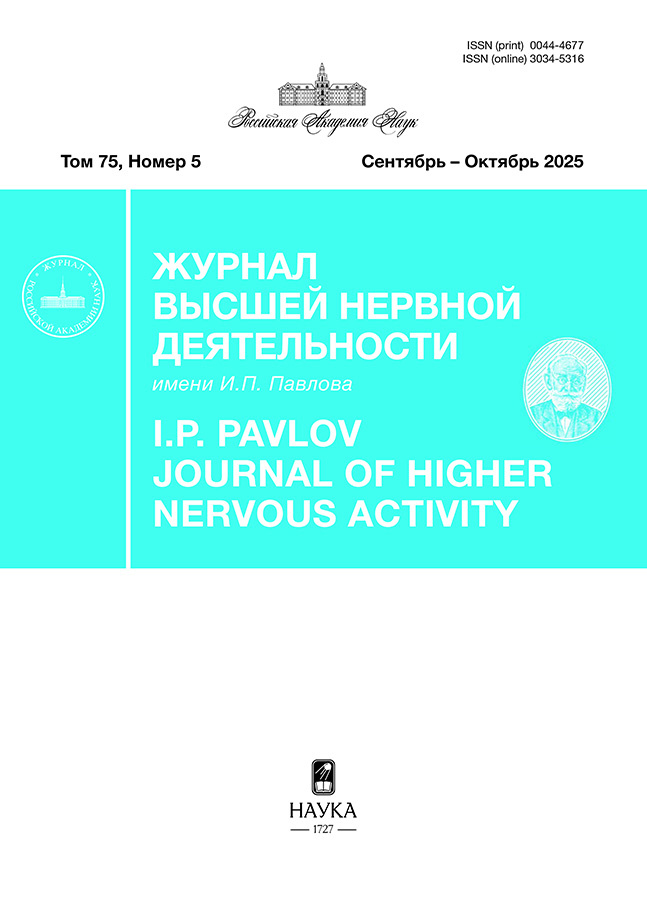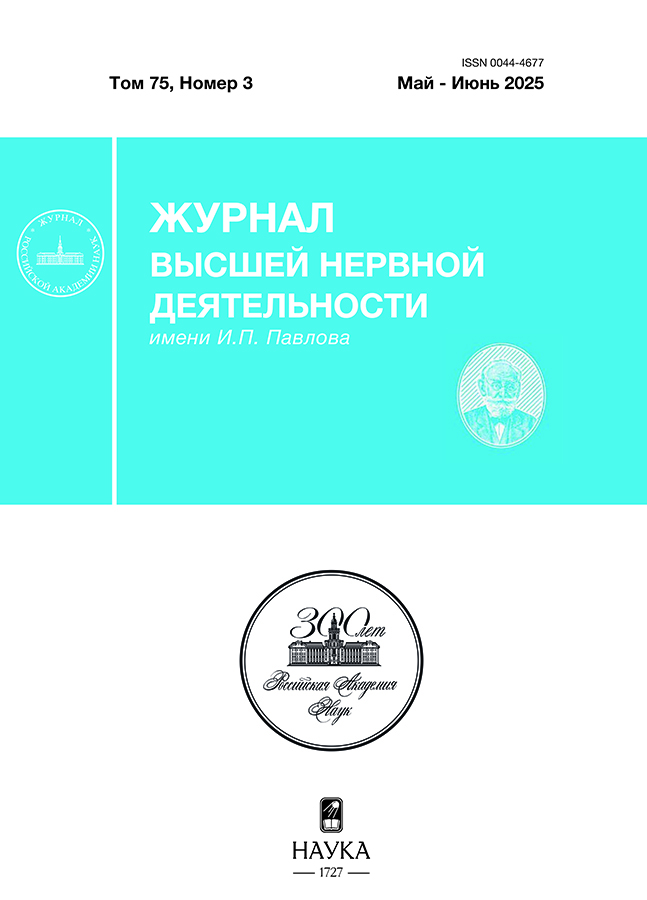Вызванные потенциалы при циклическом движении звукового сигнала
- Авторы: Шестопалова Л.Б.1, Петропавловская Е.А.1, Летягин П.И.1, Саликова Д.А.1
-
Учреждения:
- Федеральное государственное бюджетное учреждение науки Институт физиологии им. И.П. Павлова РАН
- Выпуск: Том 75, № 3 (2025)
- Страницы: 327–340
- Раздел: ФИЗИОЛОГИЯ ВЫСШЕЙ НЕРВНОЙ (КОГНИТИВНОЙ) ДЕЯТЕЛЬНОСТИ ЧЕЛОВЕКА
- URL: https://rjonco.com/0044-4677/article/view/685028
- DOI: https://doi.org/10.31857/S0044467725030057
- ID: 685028
Цитировать
Полный текст
Аннотация
Работа нацелена на изучение вызванных потенциалов (ВП) при циклическом движении звуковых стимулов, а также на выбор оптимальной модели нейронального кодирования азимутального движения. Ступенчатый или линейный паттерны движения задавали циклическими изменениями межушной задержки (ΔТ), которая изменялась на 800 мкс, а затем возвращалась к исходному значению. Статистически значимые ВП на начало движения и повторяющуюся смену направления (повороты) были обнаружены только для ступенчатого паттерна изменений ΔТ. Амплитуда ответов систематически зависела от углового положения точек поворота относительно средней линии головы. Эти результаты свидетельствуют в поддержку двухканальной модели кодирования пространственной информации в слуховой коре. ВП на остановку движения в конце сигнала указывают на участие пространственного внимания и сенсорной памяти на предсознательном этапе восприятия циклического движения.
Полный текст
Об авторах
Л. Б. Шестопалова
Федеральное государственное бюджетное учреждение науки Институт физиологии им. И.П. Павлова РАН
Автор, ответственный за переписку.
Email: shestopalovalb@infran.ru
Россия, Санкт-Петербург
Е. А. Петропавловская
Федеральное государственное бюджетное учреждение науки Институт физиологии им. И.П. Павлова РАН
Email: shestopalovalb@infran.ru
Россия, Санкт-Петербург
П. И. Летягин
Федеральное государственное бюджетное учреждение науки Институт физиологии им. И.П. Павлова РАН
Email: shestopalovalb@infran.ru
Россия, Санкт-Петербург
Д. А. Саликова
Федеральное государственное бюджетное учреждение науки Институт физиологии им. И.П. Павлова РАН
Email: shestopalovalb@infran.ru
Россия, Санкт-Петербург
Список литературы
- Семенова В.В., Шестопалова Л.Б., Петропавловская Е.А., Никитин Н.И. Константы восприятия отсроченного движения звуковых стимулов. Успехи физиологических наук. 2020. 51 (2): 55–67.
- Шестопалова Л.Б., Петропавловская Е.А. Негативность рассогласования и пространственный слух. Успехи физиологических наук. 2019. 50 (3): 14.
- Шестопалова Л.Б., Саликова Д.А., Петропавловская Е.А. Слуховое последействие: влияние неподвижного адаптера на восприятие движущегося стимула. ЖВНД. 2023. 73 (2): 256–270.
- Шестопалова Л.Б., Петропавловская Е.А., Саликова Д.А., Летягин П.И. Воспринимаемые траектории циклического движения звуковых образов. Сенсорные системы. 2024a. 38 (3): 51–62.
- Шестопалова Л.Б., Петропавловская Е.А., Саликова Д.А., Летягин П.И. Локализация точек поворота при ритмическом движении звукового образа. Физиология человека. 2024b. 50 (5): 3–12. doi: 10.31857/S0131164624050015.
- Шестопалова Л.Б., Семенова В.В., Петропавловская Е.А. Вызванный ответ мозга человека на начало движения звука (motion-onset response). Успехи физиологических наук. 2024c. 55 (3): 22–44.
- Akeroyd M.A. A binaural beat constructed from a noise. J. Acoust. Soc. Am. 2010. 128: 3301.
- Basu S., Banerjee B. Potential of binaural beats intervention for improving memory and attention: insights from meta-analysis and systematic review. Psychol. Res. 2022. https://doi.org/10.1007/s00426-022-01706-7.
- Beauchene C., Abaid N., Moran R., Diana R.A., Leonessa A. The effect of binaural beats on visuospatial working memory and cortical connectivity. PLoS ONE. 2016. 11 (11): e0166630.
- Beauchene C., Abaid N., Moran R., Diana R.A., Leonessa A. The effect of binaural beats on verbal working memory and cortical connectivity. J. Neural Engineering. 2017. 14 (2): 026014. https://doi.org/10.1088/1741-2552/aa5d67.
- Briley P.M., Goman A.M., Summerfield A.Q. Physiological evidence for a midline spatial channel in human auditory cortex. J. Assoc. Res. Otolaryngol. 2016. 17 (4): 331-40.
- Briley P.M., Kitterick P.T., Summerfield A.Q. Evidence for opponent process analysis of sound source location in humans. J. Assoc. Res. Otolaryngol. 2013. 14: 83–101.
- Briley P.M., Summerfield A.Q. Age-related deterioration of the representation of space in human auditory cortex. Neurobiol. Aging. 2014. 35: 633–644.
- Carlile S., Leung J. The perception of auditory motion. Trends Hear. 2016. 20: 1–19.
- Delorme A., Sejnowski T., Makeig S. Enhanced detection of artifacts in EEG data using higher-order statistics and independent component analysis. NeuroImage. 2007. 34 (4): 1443–1449.
- Dingle R.N, Hall S.E, Phillips D.P. A midline azimuthal channel in human spatial hearing. Hear. Res. 2010. 268: 67–74.
- Dingle R.N, Hall S.E, Phillips D.P. The three-channel model of sound localization mechanisms: interaural level differences. J. Acoust. Soc. Am. 2012. 131: 4023–4029.
- Féron F.X., Frissen I., Boissinot, J. Guastavino C. Upper limits of auditory rotational motion perception. J. Acoust. Soc. Am. 2010. 128: 3703–3714.
- Gao X., Cao H., Ming D., Qi H., Wang X., Wang X., Chen R., Zhou P. Analysis of EEG activity in response to binaural beats with different frequencies. Int. J. Psychophysiol. 2014. 94 (3): 399–406.
- Garcia-Argibay M., Santed M.A., Reales J.M. Efficacy of binaural auditory beats in cognition, anxiety, and pain perception: a meta-analysis. Psychol. Res. 2019. 83 (2): 357–372.
- Getzmann S. Auditory motion perception: onset position and motion direction are encoded in discrete processing stages. Eur. J. Neurosci. 2011. 33 (7): 1339–50.
- Getzmann S. Effect of auditory motion velocity on reaction time and cortical processes. Neuropsychologia. 2009. 47 (12): 2625–2633.
- Getzmann S. Effects of velocity and motion-onset delay on detection and discrimination of sound motion. Hearing Research. 2008. 246: 44–51.
- Getzmann S., Lewald J. Effects of natural versus artificial spatial cues on electrophysiological correlates of auditory motion. Hear. Res. 2010. 259 (1-2): 44–54.
- Grantham D.W., Wigцццhtman F.L. Detectability of varying interaural temporal differences. J. Acoust. Soc. Am. 1978. 63: 511.
- Grantham D.W., Wightman F.L. Detectability of varying interaural temporal differences. J. Acoust. Soc. Am. 1978. 63 (2): 511–523.
- Ioannou C.I., Pereda E., Lindsen J.P., Bhattacharya J. Electrical brain responses to an auditory illusion and the impact of musical expertise. PLoS ONE. 2015. 10 (6): e0129486.
- Joris Х., Smith P.H., Yin T.C. Coincidence detection in the auditory system: 50 years after Jeffress. Neuron. 1998. 21: 1235–1238.
- Licklider J.C.R., Webster J.C., Hedlun J.M. On the frequency limits of binaural beats. J. Acoust. Soc. Am. 1950. 22: 468–473.
- López-Caballero F., Escera C. Binaural Beat: A Failure to Enhance EEG Power and Emotional Arousal. Front. Hum. Neurosci. 2017. 11: 557.
- Lüddemann H., Kollmeier B., Riedel H. Electrophysiological and psychophysical asymmetries in sensitivity to interaural correlation gaps and implications for binaural integration time. Hear. Res. 2016. 332: 170–187.
- Lüddemann H., Riedel H., Kollmeier B. Asymmetries in electrophysiological and psychophysical sensitivity to interaural correlation steps. Hear. Res. 2009. 256: 39–57.
- Magezi D.A., Krumbholz K. Evidence for opponent-channel coding of interaural time differences in human auditory cortex. J. Neurophysiol. 2010. 104: 1997–2007.
- McLaughlin S.A., Higgins N.C., Stecker G.C. Tuning to binaural cues in human auditory cortex. J. Assoc. Res. Otolaryngol. 2016. 17: 37–53.
- Perrott D.R., Musicant A.D. Minimum audible movement angle: Binaural localization of moving sound sources. J. Acoust. Soc. Am. 1977. 62 (6): 1463.
- Perrott D.R., Musicant A.D. Rotating tones and binaural beats. J. Acoust. Soc. Am. 1977. 61 (5): 1288–1292.
- Phillips D.P., Hall S.E. Psychophysical evidence for adaptation of central auditory processors for interaural differences in time and level. Hearing Research. 2005. 202: 188–199.
- Pratt H., Starr A., Michalewski H.J., Dimitrijevic A., Bleich N., Mittelman N. Cortical evoked potentials to an auditory illusion: binaural beats. //Clin. Neurophysiol. 2009. 120: 1514–1524.
- Salminen N.H., Tiitinen H., May P.J.C. Auditory spatial processing in the human cortex. Neuroscientist. 2012. 18 (6): 602–12.
- Salminen N.H., May P.J.C., Alku P., Tiitinen H. A population rate code of auditory space in the human cortex. PLoS One. 2009. 4: e7600.
- Senna I., Parise C.V., Ernst M.O. Hearing in slow motion: Humans underestimate the speed of moving sounds. Sci. Rep. 2015. 5: 14054.
- Shestopalova L.B., Petropavlovskaia E.A., Salikova D.A., Semenova V.V. Temporal integration of sound motion: Motion-onset response and perception. Hear. Res. 2024. 441: 108922.
- Trapeau R., Schönwiesner M. Adaptation to shifted interaural time differences changes encoding of sound location in human auditory cortex. NeuroImage. 2015. 118: 26–38.
- Ungan P., Yagcioglu S., Ayik E. Event-related potentials to single-cycle binaural beats and diotic amplitude modulation of a tone. Exp. Brain Res. 2019a. 237: 1931–1945.
- Ungan P., Yagcioglu S., Ayik E. Event-related potentials to single-cycle binaural beats of a pure tone, a click train, and a noise. Exp. Brain Res. 2019b. 237 (11): 2811–828.
Дополнительные файлы















